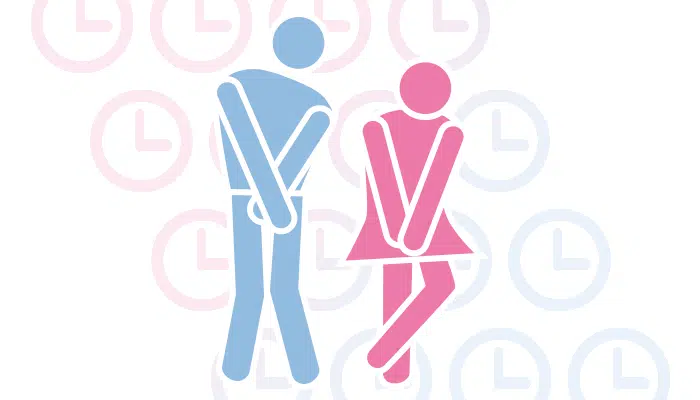What is overactive bladder?
An overactive bladder (OAB) involves a sudden urge or panic to urinate, frequent trips to the bathroom during the day and most likely at night too. For some people, OAB can lead to urinary incontinence, or urge incontinence, where there is urinary leakage with the urgency or en route to the toilet.
Common triggers for urgency are: the sound of water, cold weather, arriving home and putting the key in the door, and seeing a bathroom. OAB can have a significant impact on your quality of life, sleep, mental health and sexual function. If you have OAB, you may be avoiding social situations or avoiding drinking fluids when out and about. Perhaps you have memorised where all the toilets are wherever you go. Perhaps you are living life based on your bladder at the cost of more enjoyable activities. Or you may be worried about the symptoms worsening as you age or head towards menopause.
If you suffer with OAB, you are certainly not alone. OAB is a common problem in both men and women, affecting 12-35% of the population (Eapen & Radomski, 2016). There is hope, as there is robust evidence for managing and in many cases, completely overcoming these pesky symptoms.
What is normal bladder behaviour? How often should I urinate?
The normal number of times to urinate is 4-8 times a day, 0-1 time per night. During your awake hours the normal time between urinations is 2-4 hours. The volume of urine each time should be between 250-400ml but it can be double this first thing in the morning.
‘Normal sensation’ varies from person to person but is best described as a feeling of fullness that’s in proportion to the amount your bladder is holding and there’s no urgency or panic about the potential of urinary leakage.
How can physiotherapy help with overactive bladder and urgency?
A pelvic physiotherapist will guide your individualised bladder training program which can involve a combination of urge control strategies, pelvic floor muscle training, TENS and mindfulness. Your physiotherapist will help you work out which fluids/ bladder irritants you might be best to avoid, as it may not be all of them. They may also check that you are emptying your bladder adequately via a Real Time Ultrasound assessment.
Some patients have overactive pelvic floor muscles that can perpetuate the sensations of urgency and your physiotherapist will help you address this before any strength training. The goal of physiotherapy intervention is to regain control over your bladder for the long term.
How can I control my urgency?
Use of urge control or deferment strategies can help you to dampen the urgency of your bladder sensation. To help reduce the urge and give you more control over when you visit the bathroom, try the following strategies:
Step 1. Stop still, or even better, prepare before your trigger occurs, ie before you turn the tap on or put the key in the door
Step 2. GENTLE pelvic floor muscle contraction and relaxation.
Step 3. Try one of the following deferment strategies:
- Inhale with slow prolonged exhale through pursed lips
- Heel raises
- Calf stretches or raises
- Toe scrunches/curls
- Cross your legs (perineal pressure)
- Rub your low back area above your pelvis
- Acupressure points: inside of ankle (cross your ankles); place finger firmly on your top lip
Experiment with the above strategies and find the one that works best for you. Continue with your most effective strategy until the urge has passed, then make a decision if you need to go to the toilet or perhaps you can now wait.
Each time you reduce the need to go to the toilet, celebrate it. Lasting just 1 more minute before you urinate is an achievement and it will start to redefine the relationship you have with your bladder.
How are the pelvic floor muscles related to the bladder?
Your bladder and your pelvic floor muscles (PFM) are inextricably linked. They are next-door neighbours and also share the same nerve supply (S2-4). However, their relationship is naturally antagonistic- when your bladder fills or relaxes, the PFM contracts to allow the ‘storage’ phase to occur. Once the bladder starts to contract and enter into the ‘emptying phase’ the PFM diligently starts to relax to prepare for urination. This is great when both bladder and PFM are working well with each other. However, with OAB the relationship if often dysfunctional.
The PFM often work too hard to rein in the bladder to prevent leaking at all costs, and can end up overactive and tight. Once in this state, the PFM loses its ability to positively influence the bladder and can make the OAB symptoms worse. So before you launch into strengthening your PFM, it is best to have them assessed by your pelvic physiotherapist. Many people suffering with OAB will need their PFM released as the first step to re-establishing a healthy relationship with the bladder.
References
Eapen, R. S., & Radomski, S. B. (2016). Review of the epidemiology of overactive bladder. Research and Reports in Urology, 8, 71–76. http://doi.org/10.2147/RRU.S102441
This article was brought to you by:
Learn more about Alison Hui

